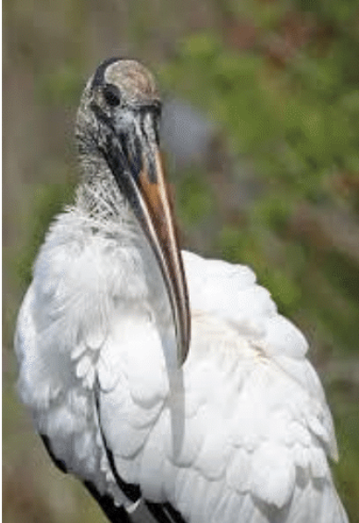
STORKS DO NOT DELIVER BABIES!
By Sid Freund
Florida Master Naturalist
Wood Storks tower over almost all the other wading birds that you will see on the berm. They have long legs, curved beaks and are white overall with black flight feathers. Tactolocation, groping with its bill in shallow water, rather than sight, helps them find their prey in murky waters. They feed by disturbing the bottom with their pink feet and snapping up small fish and crustaceans with their sensitive, long, hefty beaks. The stork sweeps its submerged bill from side to side as it walks slowly forward. Its bill snaps shut with a 25-millisecond reflex action, the fastest known for vertebrates, whenever it touches prey.
Nests are built in early spring when the water is at its lowest level, so prey is trapped in shrunken pools of water and easily caught to feed their young. The nests are built in colonies in trees and brush above standing water. They regurgitate water to keep their nestlings cool. Look for them overhead, soaring in thermals, with their necks and legs outstretched. The Wood Stork has suffered from the destruction and degradation of our state’s wetlands and is classified as “threatened” by the Federal government.
By Sid Freund
Florida Master Naturalist
Wood Storks tower over almost all the other wading birds that you will see on the berm. They have long legs, curved beaks and are white overall with black flight feathers. Tactolocation, groping with its bill in shallow water, rather than sight, helps them find their prey in murky waters. They feed by disturbing the bottom with their pink feet and snapping up small fish and crustaceans with their sensitive, long, hefty beaks. The stork sweeps its submerged bill from side to side as it walks slowly forward. Its bill snaps shut with a 25-millisecond reflex action, the fastest known for vertebrates, whenever it touches prey.
Nests are built in early spring when the water is at its lowest level, so prey is trapped in shrunken pools of water and easily caught to feed their young. The nests are built in colonies in trees and brush above standing water. They regurgitate water to keep their nestlings cool. Look for them overhead, soaring in thermals, with their necks and legs outstretched. The Wood Stork has suffered from the destruction and degradation of our state’s wetlands and is classified as “threatened” by the Federal government.
